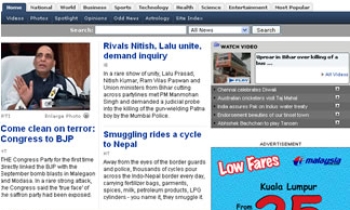LAS VEGAS (AP) - The newspaper industry this week announced a $75 million marketing campaign to declare its relevance in the Internet age as advertising revenues were flat, buffeted by major mergers and a wounded domestic auto industry.
It's the second year in a row that the Newspaper Association of America has advertised directly to its advertisers, trying to change the perception that the industry is on the decline, executives said.
"I am sick and tired of all the doom and gloom reports out there about the death of this industry," said Earl Cox, chief strategic officer of The Martin Agency, the marketing group in charge of the campaign. The perception is "inaccurate and it's unfair and it's unacceptable."
Ad revenue at its member papers in the third quarter of last year declined 1.5 percent from a year earlier to $11.79 billion, according to the NAA. Traditional print ads fell 2.6 percent to about $11.2 billion while online ads rose 23 percent to $638 million. Total ad revenues were slightly up for the first two quarters of the year.
The campaign attempts to attack the notion that newspapers are being left behind in the battle to attract consumer "eyeballs."
One campaign slogan reads: "The Internet is the best thing to happen to newspapers since the paper boy."
A central figure is a cartoon character seen reading a newspaper online while carrying a cellular phone tower and typing on two keyboards.
"This is about audience and audience is a multimedia term," said John Kimball, the association's chief marketing officer. "Newspapers have multiple channels into the marketplace that we didn't used to have and that's what we're talking about. That audience is not shrinking. That audience is growing."
While print copy circulation has been on the decline for a quarter century, Web page hits by unique visitors is growing, he said. More than 58 million unique visitors checked out online newspaper Web sites in September 2006, more than read Yahoo! News and MSNBC.com combined, he said. That's up 22 percent from the previous year.
But a core issue for papers is how those readers are counted. While many advertisers factor Web traffic into ad rates, physical circulation "is still the coin of the realm," said Neal Lulofs, spokesman for the Audit Bureau of Circulation, which checks newspaper claims of circulation and audience.
Last year, the ABC introduced a "consolidated media report" for papers that want third party proof of circulation and Web traffic presented in a "total contacts" figure.
Advertisers are also paying more attention to the demographics of a publication's audience, which can be more readily tracked online, he said.
Only about 50 newspapers have their Web traffic audited by the ABC, including The New York Times, the San Francisco Chronicle and Toronto Star, he said.
"The trend is not circulation or readership or circulation or audience, it's circulation and," Lulofs said.
The announcement of the campaign, to launch April 2, came as The New York Times Co. announced Wednesday a large writedown on two papers it acquired, The Boston Globe and the Worcester Telegram & Gazette, giving it a net loss of $648 million for the three-month period ended in December. Revenue rose 4.3 percent to $931.5 million, ahead of analysts' estimates.
The trouble at the two subsidiaries reflects a problem for the newspaper business as a whole, said analyst Edward Atorino with The Benchmark Company. Major telecom and retail company mergers, along with a struggling auto and real estate sector, have caused ad spending overall to stagnate.
"Their efforts have been blunted, thwarted by circumstances beyond their control," Atorino said. "There's been a dramatic shift in advertising spending across a range of categories that has affected advertising growth overall. It just disappeared."
Some seminars at the NAA's annual marketing conference in Las Vegas, which ran from Sunday to Wednesday, urged some 2,000 member newspapers in the U.S. and Canada to make use of their online presence to boost subscriptions and provide more value to advertisers.
Scott Stines, president of mass2one, said his company's permission-based e-mail marketing program has helped newspapers retain customers and extract a few more advertising dollars from ad clients.
"There's no home runs, there's no grand slams in any media channel," he said. "It's about singles and bunts and bases on balls. It's about every little incremental thing."









